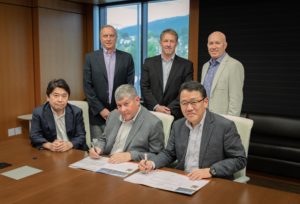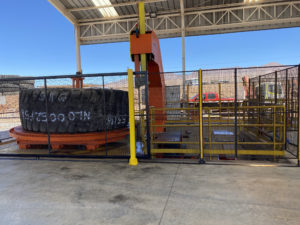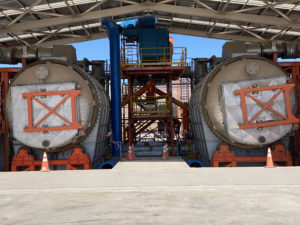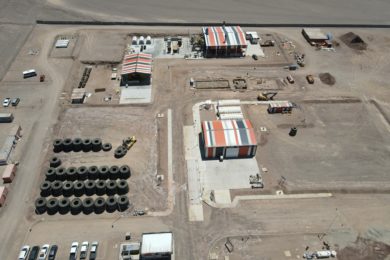In September, Kal Tire’s Mining Tire Group, the leading international mining tyre supply and management partner, and Mitsui & Co, a global corporate group focusing on innovation and sustainability, announced the formation of a landmark joint venture aimed at advancing mining tyre recycling solutions for mining regions around the world. Paul Moore caught up with Dan Allan, Senior Vice President, Kal Tire’s Mining Tire Group to get some additional insight into the new partnership
Q What value does Mitsui bring to Kal Tire in your mining tyre recycling plans and roadmap?
Mitsui has been an active investor in the mining space for many years. They know mining companies very well with major investments and partnerships with Tier 1 miners at some of the world’s major mines. That will help us gain insights on how these mining companies are thinking about end-of-life tyre management and potential recycling solutions. We know that tyre recycling is getting a lot of attention these days, and there are lot of questions to answer. Our collaboration with Mitsui will provide much more insight into the circular economy and sustainability ambitions within the top tier miners.
The Kal Tire-Mitsui JV signing

Q Mitsui is also one of the world’s largest trading houses – was that a factor in the collaboration and will they actively be involved in further refining of and marketing of the products of mining tyre recycling including carbon black?
This is not part of the collaboration plan currently but is certainly a possibility. This partnership arose because Mitsui wanted to see how they can participate better in sustainable mining, the circular economy and the related value chain in a meaningful way – and not just as an investor. This allows them to get involved directly in the mining tyre recycling industry at an early stage, and with an operating partner that has already developed and brought an industrial scale thermal conversion facility close to commercialisation stage. However, as you have said they also have expertise in chemical engineering and materials technology which will help us when we look to build relationships in downstream markets for the products of tyre thermal conversion.
Q How did the partnership come about in the first place?
We began talking with Mitsui on the subject of mining tyre sustainability over five years ago and it became clear that tyre recycling was where there could really be value for both parties – and that both parties really had something to bring to a potential joint venture. For us as Kal Tire it was also important that the spirit and values of their organisation matched well with ours, as a JV on something like this was a really big step for us – and we felt really comfortable with Mitsui.
The Antofagasta facility is included in the joint venture

Q You spent a number of years progressing the Antofagasta recycling facility – will it and any additional mining tyre recycling plants now be jointly owned by the JV?
The joint venture we have formed is specifically related to the recycling of mining tyres on an international basis. Anywhere that we have Kal Tire operations or aspirations, then the mining tyres recycling JV will include those geographies. The idea is that every plant and site we look at has the potential to have its own structure based on the specific market contexts, and the JV will have flexibility to tailor that business to the needs of the local markets. In some cases, the JV will own the plants outright but in other cases there may be other approaches. For example, if we decided to have a separate mining tyre recycling plant serving one mining operation, you could have a joint venture between the Mitsui-Kal Tire JV and the mining customer. And we are also including our existing Antofagasta plant in the JV.

Q Mining tyre recycling is already legislated in Chile and it looks like other countries like Colombia, Peru and Canada will follow. Will the JV make it easier to manage expansion of this part of your business?
Mitsui is a huge company with a lot of available capital; and if the mining tyre recycling demand increases to the level that we and Mitsui foresee, their partnership in the JV will clearly be a major part in our being able to initially fund any significant expansion of the existing plant and other plants in major mining regions.
Q Where do we go from here now that the JV has been announced? What are the next steps?
An international company has been formed and will operate under the name Kal Tire Recycling. This will be the company that will determine the priority mining tyre recycling markets, how funding will be put together for different regions, and all operating companies for the recycling plants will come under this holding company. We are transferring the Antofagasta plant assets to that structure, which will serve as the model for other plants as they evolve. And as stated we have the flexibility to include mining customers or indeed other local stakeholders and investors in the operating company ownership structures of these future plants, with the Kal Tire-Mitsui holding company retaining the majority.
Q What has the response been from your mining customers since the JV was announced?
We were looking for a partner that understood what the future mining tyre recycling market could look like – how to capitalise on that and how to deliver and develop downstream markets for the thermal conversion products. I think most miners assumed that we would go down a partnership route but some expected that it would be with one of the major tyre manufacturers. We do work closely and well with the manufacturers as part of our tyre supply and tyre management businesses, and they will be an integral part of the mining tyre recycling downstream business in terms of potential carbon black use. But for a JV partner, we felt Mitsui was the optimal fit given their presence in mining already, and the capabilities they possess in various engineering spaces. We see the tyre manufacturers as important players in this recycling space. However, the solutions to end-of-life tyre challenges must be ‘brand agnostic.’ It is an industry issue, not one for any one specific manufacturer.










